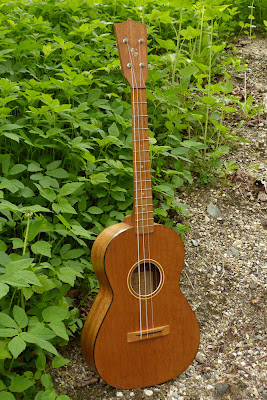c.1960 Luna Baritone Ukulele
Luna ukuleles are relatively rare over here, but over in Japan they were the preeminent brand during the 50s and 60s. There's a good reason for this as every single one I've had the chance to work on has sounded amazing despite the simple construction. This one has a laminate mahogany (or some sort of similar Asian mahogany species) body with a solid mahogany neck, but like the modern Japanese-made Kiwaya laminate ukes, the use of a laminate body hardly matters because the ultra-light build and good design means that the tone from this instrument is excellent.
My work on this bari included a fret level/dress, bridge reglue, some seam reglues, cleaning, and setup. It plays beautifully with 1/16" action at the 12th fret, strung with light-gauge Martin fluorocarbon bari strings. This uke has a long 20 1/8" bari scale plus a very thin, fast (more uke than bari uke style) neck, and so I suggest a pretty light-gauge set for instruments like these.
The body shape and 14th-fret join is reminiscent of Martin ukes though the absence of a fretboard extension over the body gives this a decidedly more vintage, 1930s feel. It's great for someone like me who likes to fingerpick and strum above the soundhole as the fingers don't rub up against the tail end of a board. It also looks minimalistically cool.
Rosewood nut, Luna "shield" decal.
The frets and real pearl dots are put right into the face of the neck. There's no additional fretboard on it. This evokes 1920s Hawaiian ukes for me. Also note the different-sized dots. Cute!
Black binding on the top edge, white binding around the soundhole, and an inlaid, simple rosette.
Mahogany bridge with some sort of hard, synthetic saddle. I like the uke-style bridge on this way better than the classical-style bridges one normally sees on baris. It means the footprint is smaller and this, combined with the single-brace design on the inside (only one mid brace), means that the top gets the most out of the relatively light tension of baritone uke strings.
The back has some light chipout at the edges here and there of the top layer of the ply, but it still looks just fine. When this was made, none of the grain was filled, so the finish has a porous, utilitarian look, not unlike Harmony guitars of the period.
The simple friction pegs work just fine.
Good joint! This has a dowel-reinforced dovetail joint right from the factory.
Overall, a really sweet bari uke with a sort of "breathy," full tone. This is a super fingerpicker's instrument but also does especially well for flamenco-style chording.














Comments